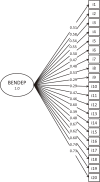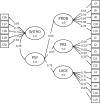Psychometric properties of the Benzodiazepine Dependence Self-Report Questionnaire - Portuguese Version (BENDEP-SRQ-PV)
- PMID: 33263708
- PMCID: PMC7879080
- DOI: 10.1590/2237-6089-2019-0049
Psychometric properties of the Benzodiazepine Dependence Self-Report Questionnaire - Portuguese Version (BENDEP-SRQ-PV)
Abstract
Objective: To assess psychometric properties of the Benzodiazepine Dependence Self-Report Questionnaire - Portuguese Version (BENDEP-SRQ-PV) in a sample of Brazilian chronic hypnotic users.
Methods: One hundred and seventy-nine chronic hypnotic users (benzodiazepines and Z-drugs) were recruited, attended a psychiatric evaluation, and answered the BENDEP-SRQ-PV. Factor structure, reliability, and influence of covariates (dependence diagnosis and type of drug consumed) were assessed in a structural equation modelling environment. Discrimination was assessed with receiver operating characteristic (ROC) plots and stability with the test-retest method.
Results: Participants, mostly women (91.6%), aged 51 to 64 years old, had been using hypnotics for an average of 34.8 months, with a mean defined daily dose of 0.72. Psychometric analysis demonstrated construct and criterion validity, reliability, and response stability. The factor structure was maintained as originally proposed: problematic use (ω = 0.73), preoccupation (ω = 0.74), lack of compliance (ω = 0.74), and withdrawal (ω = 0.93).
Conclusion: The BENDEP-SRQ-PV is an adequate measure of hypnotic dependence in the Brazilian population of chronic users. Our results support using the scale for follow-up in clinical and research applications and in correlational studies.
Conflict of interest statement
Disclosure
No conflicts of interest declared concerning the publication of this article.
Figures



Similar articles
-
Scalability, reliability, and validity of the benzodiazepine dependence self-report questionnaire in outpatient benzodiazepine users.Compr Psychiatry. 1999 Jul-Aug;40(4):283-91. doi: 10.1016/s0010-440x(99)90129-3. Compr Psychiatry. 1999. PMID: 10428188
-
Cross-validation of the benzodiazepine dependence self-report questionnaire in outpatient benzodiazepine users.Compr Psychiatry. 2001 Sep-Oct;42(5):433-9. doi: 10.1053/comp.2001.26275. Compr Psychiatry. 2001. PMID: 11559871
-
Current state of hypnotic use disorders: Results of a survey using the Japanese version of Benzodiazepine Dependence Self-Report Questionnaire.Neuropsychopharmacol Rep. 2021 Mar;41(1):14-25. doi: 10.1002/npr2.12149. Epub 2020 Dec 1. Neuropsychopharmacol Rep. 2021. PMID: 33259705 Free PMC article.
-
Screening accuracy of the German version of the benzodiazepine self-report questionnaire.Compr Psychiatry. 2025 Aug;141:152607. doi: 10.1016/j.comppsych.2025.152607. Epub 2025 May 18. Compr Psychiatry. 2025. PMID: 40408792
-
Cross-validation, predictive validity, and time course of the Benzodiazepine Dependence Self-Report Questionnaire in a benzodiazepine discontinuation trial.Compr Psychiatry. 2003 May-Jun;44(3):247-55. doi: 10.1016/S0010-440X(03)00040-3. Compr Psychiatry. 2003. PMID: 12764713 Clinical Trial.
Cited by
-
Dependence on hypnotics: a comparative study between chronic users of benzodiazepines and Z-drugs.Braz J Psychiatry. 2022 May-Jun;44(3):248-256. doi: 10.1590/1516-4446-2020-1651. Braz J Psychiatry. 2022. PMID: 34133689 Free PMC article.
References
-
- 4. Schonmann Y, Goren O, Bareket R, Comaneshter D, Cohen AD, Vinker S. Chronic hypnotic use at 10 years-does the brand matter? Eur J Clin Pharmacol. 2018;74:1623-31. - PubMed
- Schonmann Y, Goren O, Bareket R, Comaneshter D, Cohen AD, Vinker S. Chronic hypnotic use at 10 years-does the brand matter? Eur J Clin Pharmacol. 2018;74:1623–1631. - PubMed
-
- 5. Moloney ME, Konrad TR, Zimmer CR. The medicalization of sleeplessness: a public health concern. Am J Public Health. 2011;101:1429-33. - PMC - PubMed
- Moloney ME, Konrad TR, Zimmer CR. The medicalization of sleeplessness: a public health concern. Am J Public Health. 2011;101:1429–1433. - PMC - PubMed

